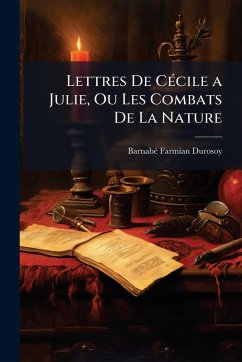Lettres de Cécile à Julie, Ou Les Combats de la Nature, written by Barnabé Farmian Durosoy and published in 1764, is a captivating example of the epistolary novel from 18th-century France. This collection of letters between Cécile and Julie delves into the complexities of human nature and societal expectations, offering a window into the intellectual and emotional landscape of the time. Durosoy's work provides valuable insights into the social dynamics and literary trends of pre-revolutionary France. The intimate format of the letters allows for a nuanced exploration of themes such as friendship, morality, and the challenges faced by women in a patriarchal society. "Lettres de Cécile à Julie" remains a significant contribution to French literature, showcasing the enduring power of personal correspondence as a means of exploring profound philosophical and emotional questions. This work has been selected by scholars as being culturally important, and is part of the knowledge base of civilization as we know it. This work was reproduced from the original artifact, and remains as true to the original work as possible. Therefore, you will see the original copyright references, library stamps (as most of these works have been housed in our most important libraries around the world), and other notations in the work. This work is in the public domain in the United States of America, and possibly other nations. Within the United States, you may freely copy and distribute this work, as no entity (individual or corporate) has a copyright on the body of the work. As a reproduction of a historical artifact, this work may contain missing or blurred pages, poor pictures, errant marks, etc. Scholars believe, and we concur, that this work is important enough to be preserved, reproduced, and made generally available to the public. We appreciate your support of the preservation process, and thank you for being an important part of keeping this knowledge alive and relevant.
Bitte wählen Sie Ihr Anliegen aus.
Rechnungen
Retourenschein anfordern
Bestellstatus
Storno

